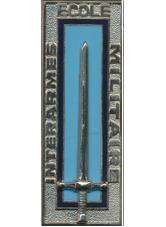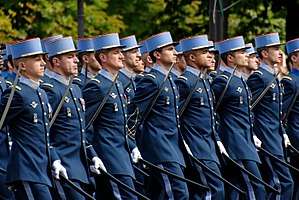École militaire interarmes
The Combined Arms School or Joint military school, known as École Militaire Interarmes or EMIA, is a military school of the French Army intended to train officers who have risen from the ranks. It was founded in 1942 and based in a rural location, Coëtquidan (Morbihan) along with Saint-Cyr military school.
| Combined Arms School | |
|---|---|
| École Militaire Interarmes | |
 Combined Arms School insignia | |
| Active | 1942 - 1961 |
| Country | France |
| Branch | French Army |
| Type | Training |
| Role | Army Officer Training |
| Size | Two brigade (subject to review) |
| Part of | Army Recruiting and Training Division |
| Garrison/HQ | Camp de Coëtquidan |
| Nickname(s) | Dolo |
| Motto(s) | 'Le travail pour loi, l'honneur comme guide "Work for law, honor as a guide" |
| Colours | Blue |
| March | Sarie Marès |
| Website | Official website |
| Commanders | |
| Current commander | Major General Antoine Windeck |
| Chief of Army Staff | President of the French Republic Emmanuel Macron |
History
The EMIA is the heir of various military branch (i.e. infantry, cavalry and artillery) schools dating from the early 19th century and intended to train army officers promoted from the ranks (militaires du rang), from non-commissioned officers (sous-officiers) or from the reserves (anciens officiers de réserve). The largest of these army branch schools was the infantry school of Saint-Maixent, which was merged with Saint-Cyr in 1942. The merged academies formed the School of Cherchell-Mediouna, created after the German occupation of the Southern Zone of France. In 1944 the Military Academy at Cherchell took the name of "Joint Military Academy." It moved to Coëtquidan, occupying the buildings of the former Academy of Saint-Cyr. These were subsequently destroyed by bombing. The new school was reopened in 1947, taking the name of the "Joint Special Military School". Following the principles of amalgamation favoured by its founder, General de Lattre de Tassigny, the school comprised both "direct" officer-cadets entering from civilian life and chosen through external competition; and "semi-direct" officer-cadets selected from serving military personnel. This system was retained until 1961, when the training of "direct" officers was transferred to the School of Saint-Cyr, and that of "semi-direct" officers was undertaken by the EMIA. Undergraduate students receive a three-year university degree and graduate students receive a one year Master's Degree.
Recruitment and Selection
In the past, candidates were selected at the Ecole Militaire of Strasbourg. The EMS consisted of two branches: the battalion of unique contest Services (CUS) and the pre-competition pack EMIA (PPEMIA). EMS students also had the opportunity to attend a competition for engineers auxiliary armament.
- The competition to enter the Ecole Militaire InterArmes :
- be between 30 and 55 years old.
- be baccalaureate.
- be in the Army for at least 3 years, on January 1 of the competition year.
- be physically fit.
- Events:
- Having entered the competition in his unit, the officer must choose one of three courses for the examination sciences (SI), General Studies (GS), military science (MS). Then, candidates must first pass a series of written tests to qualify and successfully pass a series of oral and physical tests to be admitted.
- 1.The written test.
- 2.the oral tests.
Traditions
EMIA students are nicknamed "dolos" after the brand of corned beef of old combat rations. During ceremonies, they wear the parade dress uniform, called "TP" and the curved cavalry saber, representing the future duty as commissioned officers upon graduation. They wear a light blue and red kepi, inherited from the Cherchell Officer Cadet Schoiol.
The songs are EMIA tradition Prayer and Sarie Marès. A popular phrase: "One day Dolo, Dolo forever! '
Classes since 1961

| 1 | 1961–1962 | Capitaine Bourgin |
| 2 | 1962–1963 | Serment de Koufra |
| 3 | 1963–1964 | Belvédère |
| 4 | 1964–1965 | André Zirnheld.[1] |
| 5 | 1965–1966 | Cinquantenaire de Verdun |
| 6 | 1966–1967 | Connétable du Guesclin |
| 7 | 1967–1968 | Narvik.[2] |
| 8 | 1968–1969 | Libération de Strasbourg |
| 9 | 1969–1970 | Plateau des Glières |
| 10 | 1970–1971 | Général Kœnig.[3] |
| 11 | 1971–1972 | Souvenir [4] |
| 12 | 1972–1973 | Général Marceau.[5] |
| 13 | 1973–1974 | Général Brosset.[6] |
| 14 | 1974–1975 | Capitaine Cazaux [7] |
| 15 | 1975–1976 | Capitaine Cardonne.[8] |
| 16 | 1976–1977 | Capitaine de Belsunce [9] |
| 17 | 1977–1978 | Lieutenant Chezeau [10] |
| 18 | 1978–1979 | Général Laurier |
| 19 | 1979–1980 | Lieutenant-colonel Broche.[11] |
| 20 | 1980–1981 | Capitaine Cozette [12] |
| 21 | 1981–1982 | Centenaire [13] |
| 22 | 1982–1983 | Lieutenant Leclerc de Hauteclocque |
| 23 | 1983–1984 | Lieutenant Borgniet |
| 24 | 1984–1985 | Lieutenant Bernard de Lattre de Tassigny. |
| 25 | 1985–1986 | Lieutenant Lhuillier |

| 26 | 1986–1988 | Dalat |
| 27 | 1987–1989 | Capitaine Legrand.[14] |
| 28 | 1988–1990 | Valmy [15] |
| 29 | 1989–1991 | Bataillon de Corée |
| 30 | 1990–1992 | Général Daboval |
| 31 | 1991–1993 | Capitaine Barrès. (Biographie de Claude Barrès) [16] |
| 32 | 1992–1994 | Combats de Tu-Le |
| 33 | 1993–1995 | Capitaine Maine. |
| 34 | 1994–1996 | Cadets de Cherchell. |
| 35 | 1995–1997 | Lieutenant Schaffar [17] |
| 36 | 1996–1998 | Général Gandoët.[18] |
| 37 | 1997–1999 | Grande Guerre |
| 38 | 1998–2000 | Général Berge.[19] |
| 39 | 1999–2001 | Campagne d'Italie |
| 40 | 2000–2002 | Capitaine Coignet |
| 41 | 2001–2003 | Capitaine Biancamaria.[20] |
| 42 | 2002–2004 | Lieutenant de Ferrières. |
| 43 | 2003–2005 | Général de Lanlay. |
| 44 | 2004–2006 | Colonel Guéguen.[21] |
| 45 | 2005–2007 | Colonel Delcourt. |
| 46 | 2006–2008 | Lieutenant De La Batie. |
| 47 | 2007–2009 | Général de Corps d'Armée Le Ray. |
| 48 | 2008–2010 | Capitaine Flores.[22] |
| 49 | 2009–2011 | Colonel du Puy-Montbrun.[23] |
| 50 | 2010–2012 | Général Bigeard [24] |
| 51 | 2011–2013 | Maréchal Bessières [25] |
| 52 | 2012–2014 | Ceux d'Afghanistan [26] |
See also
- Camp de Coëtquidan
- L'Épaulette magazine
- École nationale des sous-officiers d'active
- École spéciale militaire de Saint-Cyr
References
- Site de la promotion Zirnheld
- "Promotion NARVIK". www.promotionnarvik.fr.
- "Orange". pp.auto.ke.orange.fr.
- "Pages perso Orange – Créez facilement votre site web personnel". pages.perso.orange.fr.
- Site de la promotion Général Marceau
- "Promotion Général Brosset". promotionbrosset.org.
- "Visiteur". cazaux1974.free.fr.
- "HugeDomains.com - Cardonne.com is for sale (Cardonne)". www.hugedomains.com.
- "Accueil". www.promotion-capitaine-de-belsunce.fr.
- "Accueil - Chezeau". www.chezeau.fr.
- "Pages perso Orange - Domaine obselète". promotion-lcl-broche.monsite.wanadoo.fr.
- Site de la promotion Capitaine Cozette
- "CENTENAIRE: Page d'accueil". centenaire.chez.com.
- "Pages perso Orange - Domaine obselète". cne_legrand.perso.orange.fr.
- Site de la promotion Valmy
- Site de la promotion Capitaine Barrès
- "EMIA - Promotion Lieutenant Schaffar". www.emia-schaffar.com.
- "EMIA - Association des anciens élèves de la Promotion Général Gandoët". www.emia-gandoet.com.
- "PROMOTION GENERAL BERGE". emiaberge.chez.com.
- "P R O M O T I O N C N E B I A N C A MA R I A". cnebiancamaria.free.fr.
- "Ce compte est suspendu". www.emia44.com.
- Site de la promotion Capitaine Flores
- Site de la promotion Colonel du Puy-Montbrun
- "Promotion général Bigeard". www.emia50.fr.
- "Accueil". Promotion Maréchal Bessières.
- Site de la promotion Ceux d'Afghanistan